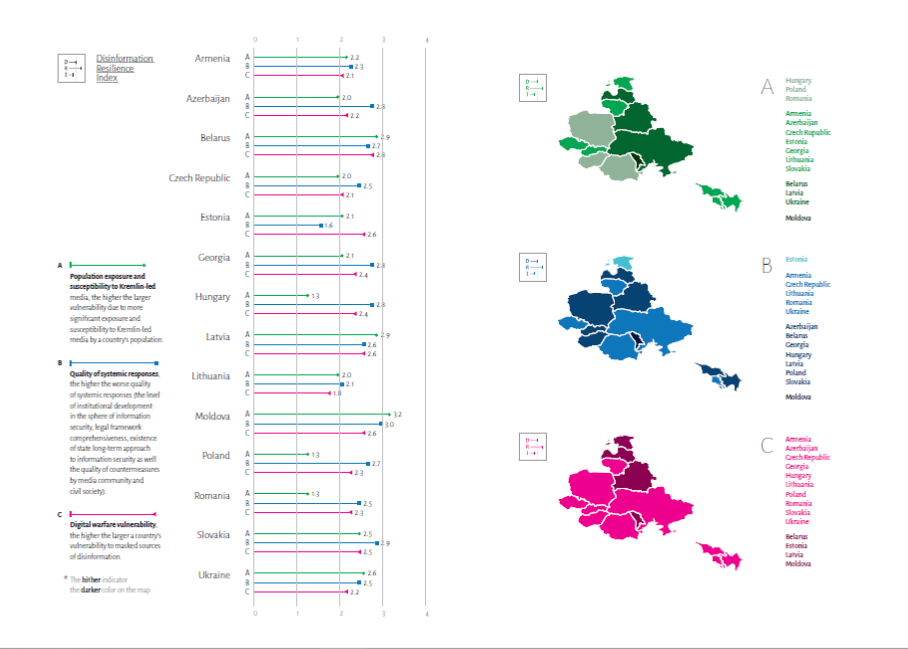
21 Jun Disinformation Resilience in Central and Eastern Europe
June 2018 by Daniel Bartha
Disinformation Resilience in Central and Eastern Europe
This book is a result of the research which was carried out in May 2017 – May 2018 by the Foreign Policy Council “Ukrainian Prism” and the Eurasian States in Transition research center (EAST Center) in cooperation with other CEE research centers (including CEID) in the framework of the project “Assessing Vulnerability and Resilience to Russian Disinformation Warfare: Practical Overview and Qualitative Evaluation of Critical Infrastructure”.
The research is aimed at assessing national vulnerabilities and preparedness to counteract foreign-led disinformation in 14 countries of Eastern and Central Europe. The Visegrad states (Czech Republic, Hungary, Poland, Slovakia), Eastern Partnership countries (Azerbaijan, Armenia, Belarus, Georgia, Moldova, Ukraine), the Baltic countries (Estonia, Latvia, Lithuania) and Romania are covered. An integral part of the research is the Disinformation Resilience Index, which is quantitative assessment of exposure to Kremlin-led disinformation and the level of national resilience to disinformation campaigns.
Based on an analysis of data collected by the EU’s East StratCom Task Force in its Disinformation Reviews, four basic categories of disinformation were singled out, namely:
a ) unsourced or falsified claims;
b ) non-credible claims with sources;
c ) claims based on earlier unsourced or non-credible claims; and,
d ) conspiracy theories.
Consequently, scholars argue that Kremlin disinformation is effective thanks to a variety of methods, which all can be classified within three categories, namely, exploiting differences in media systems (strategic asymmetry), targeting of disenfranchised or vulnerable audiences (tactical flexibility), and having the ability to mask the sources
of disinformation (plausible deniability). The country chapters’ and DRI indicators’ design partly reflects these considerations. The exploratory research design is based on desk research, in-depth expert interviews, and online expert surveys.
A few of the key findings and most important outcomes of the analysis are:
- The elderly and national minorities are most often the most susceptible to Kremlin-led disinformation and propaganda. Older people in CEE countries tend to display nostalgic feelings for the Soviet/socialist past and usually are inexperienced users of modern technological tools
- National minorities are considered an easy target for Kremlin-backed disinformation, and this category goes far beyond ethnic Russians across the region.
- Active followers of the Orthodox Christian church are another prominent vulnerable group to Kremlin-led disinformation
- An equally vulnerable and compromised societal group are the supporters of far-right ideology and so-called ‘ideologies for hire’ – right-wing extremism, racist rhetoric, fascism, ultra-nationalism, ‘conservatism’, etc. Kremlin-led disinformation and propaganda is highly successful in the identification and consolidation of such groups.
- Several country experts report that young people under 25 are yet another group at risk. Furthermore, there are some other country-specific vulnerable groups.
- While acknowledging the quality and diversity of Kremlin-led disinformation methods, one should not exaggerate their sophistication. Experts express doubt that Russia actually possesses a specific media strategy towards any given CEE country.
- The usage and popularity of Russian-language media platforms heavily determines the degree of population exposure to Kremlin-led messages.
- Virtually all CEE countries lack quality systemic responses. National institutions and regulations on information security are often underdeveloped and the regulatory environment is outdated.
- Another common feature across the CEE countries is a deficiency of national long-term strategies aimed at combating foreign-led disinformation campaigns and producing coherent narratives towards vulnerable groups of the population.
- To reach its audiences in European countries, Russia regularly exploits loopholes in EU regulations.
- The recently installed media self-regulatory mechanisms in the CEE countries are mostly ineffective.
- The experts positively assess the role of civil society in withstanding foreign-triggered disinformation and manipulation campaigns.
- Generally, the most popular radio and newspapers are less frequent transmitters of Kremlin-led disinformation across CEE countries than TV channels and online media.
You can get access to the whole paper here.

